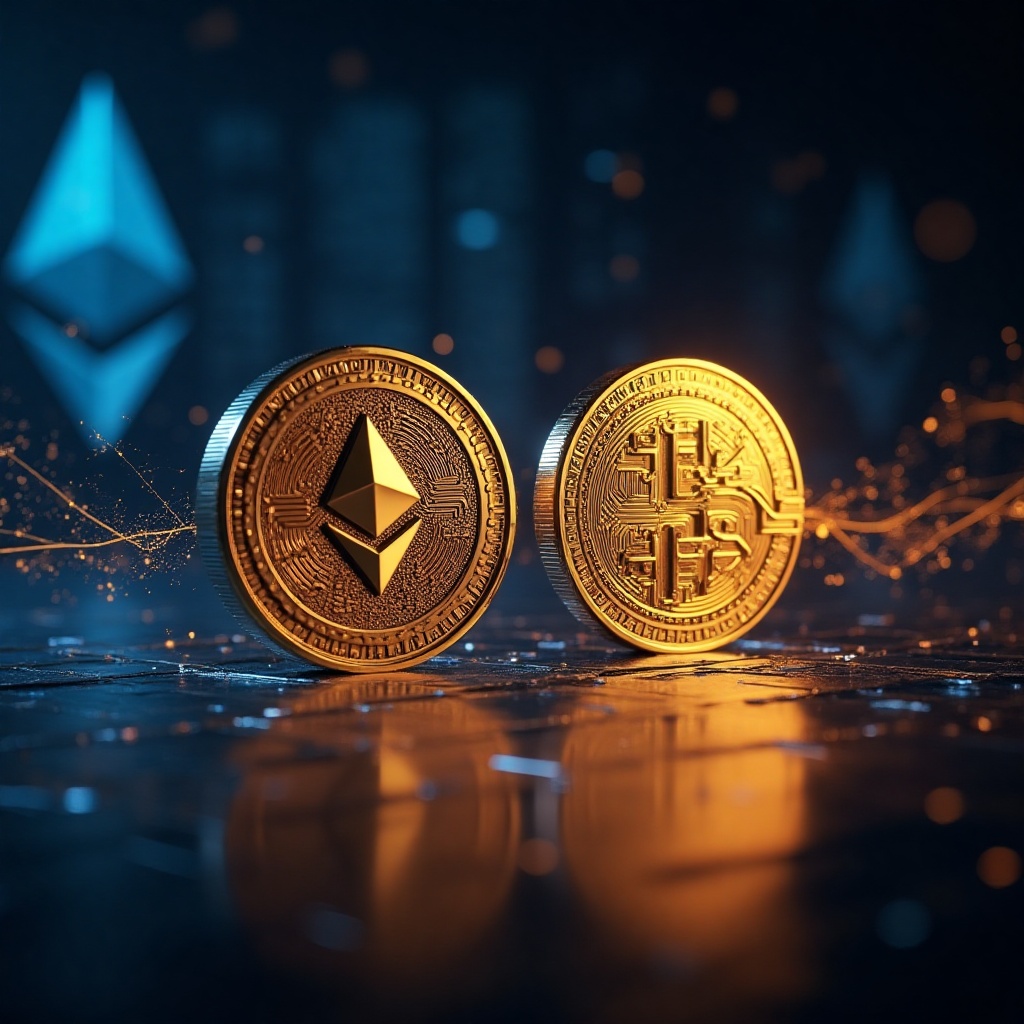In the ever-evolving landscape of blockchain technology, Non-Fungible Tokens (NFTs) have emerged as a revolutionary force, transforming various industries by providing a means to represent ownership and authenticity of unique digital assets. Whether it’s digital art, collectibles, or in-game items, NFTs have opened new avenues for creators, developers, and collectors alike.
At the heart of this transformation lies the choice of the underlying token standard. Among the most prominent are ERC-721 and ERC-1155, both of which serve as blueprints for creating NFTs on the Ethereum blockchain. However, understanding the nuances of each standard is crucial for developers and creators aiming to leverage NFTs effectively.
This article aims to provide a comprehensive comparison between ERC-721 and ERC-1155, shedding light on their respective features, advantages, and ideal use cases. By the end, you’ll be equipped with the knowledge to make an informed decision on which standard aligns best with your project’s objectives.
Understanding NFT Token Standards: The Basics
What Are NFT Token Standards?
In the realm of blockchain, particularly on the Ethereum network, NFT token standards are predefined sets of rules and interfaces that dictate how non-fungible tokens (NFTs) should behave. These standards ensure consistency, interoperability, and security across various applications and platforms.
Think of them as blueprints that developers follow to create NFTs. Without these standards, each NFT could function differently, leading to confusion and inefficiencies.
The Role of Ethereum Request for Comments (ERC)
The term “ERC” stands for Ethereum Request for Comments. It’s a formal process used by the Ethereum community to propose improvements or additions to the network. Each proposal is assigned a number, and if accepted, it becomes an official standard.
For instance:
ERC-20: Defines a standard for fungible tokens, like stablecoins.
ERC-721: Establishes a standard for unique, non-fungible tokens.
ERC-1155: Introduces a multi-token standard that can handle both fungible and non-fungible tokens.
These standards are crucial because they provide a common framework that ensures different applications, wallets, and marketplaces can interact seamlessly with NFTs.
Importance of NFT Token Standards
Interoperability: By adhering to a standard, an NFT created on one platform can be recognized and used on another. This is vital for the growth and adoption of NFTs across various ecosystems.
Security: Standards undergo rigorous scrutiny by the community, ensuring that they are secure and free from vulnerabilities.
Efficiency: Developers can leverage existing standards to build applications faster, reducing the need to reinvent the wheel for each new project.
User Experience: For collectors and users, standards mean consistency. They can expect similar behaviors and features across different NFTs, making the ecosystem more user-friendly.
In summary, NFT token standards are the backbone of the NFT ecosystem, providing structure, security, and consistency. Understanding these standards is the first step in navigating the world of NFTs and making informed decisions about which standard best suits your project’s needs.
Deep Dive into ERC-721
Core Characteristics of ERC-721
Uniqueness: Each ERC-721 token has a unique identifier (tokenId), ensuring that no two tokens are alike. This uniqueness is what gives NFTs their value and authenticity.
Ownership Tracking: The standard includes functions like ownerOf(tokenId) to track the owner of each token, providing transparency and security.
Transferability: ERC-721 tokens can be transferred between addresses using functions like safeTransferFrom(from, to, tokenId), ensuring that the transfer is secure and that the recipient can handle the token.
Metadata: Each token can have associated metadata, typically stored off-chain, that provides additional information about the asset it represents. This metadata can be accessed via a URI (tokenURI(tokenId)).
Technical Specifications
ERC-721 is defined by the Ethereum Improvement Proposal (EIP) 721. It specifies a set of functions and events that a smart contract must implement to be considered ERC-721 compliant. These include:
balanceOf(owner): Returns the number of NFTs owned by a given address.
ownerOf(tokenId): Returns the owner of a specific token.
safeTransferFrom(from, to, tokenId): Transfers the ownership of a token from one address to another.
approve(to, tokenId): Grants or revokes permission to another address to transfer a specific token.
getApproved(tokenId): Returns the approved address for a specific token.
setApprovalForAll(operator, approved): Grants or revokes permission to an operator to manage all of the caller’s tokens.
isApprovedForAll(owner, operator): Returns whether an operator is approved to manage all of the owner’s tokens.
tokenURI(tokenId): Returns a URI pointing to the metadata of a specific token.
These functions ensure that ERC-721 tokens are interoperable across different platforms and applications within the Ethereum ecosystem.
Real-World Applications
Digital Art: Artists can tokenize their work, providing proof of ownership and enabling direct sales to collectors.
Gaming: In-game assets like skins, weapons, and characters can be tokenized, allowing players to truly own and trade their items.
Collectibles: Platforms like CryptoKitties have demonstrated the potential of ERC-721 in creating digital collectibles that can be bred, traded, and sold.
Real Estate: Virtual real estate in metaverse platforms can be represented as ERC-721 tokens, allowing for transparent ownership and transactions.
Identity Verification: ERC-721 tokens can represent unique identifiers, such as certificates or licenses, providing a secure and verifiable means of identity.
Limitations of ERC-721
Gas Costs: Interacting with ERC-721 tokens can be gas-intensive, especially when transferring multiple tokens, due to the need for separate transactions.
Lack of Batch Operations: ERC-721 does not natively support batch transfers, requiring multiple transactions to transfer multiple tokens, which can be inefficient.
Metadata Storage: Storing metadata off-chain introduces concerns about data permanence and reliance on external services.
Limited Fungibility: Each token is unique, which may not be suitable for applications requiring interchangeable assets.
Despite these limitations, ERC-721 remains a foundational standard in the NFT space, providing a robust framework for creating unique digital assets.
Deep Dive into ERC-1155
Core Characteristics of ERC-1155
Multi-Token Support: ERC-1155 enables the creation of multiple token types within a single contract. This means developers can mint fungible tokens (like in-game currency), non-fungible tokens (unique items), and semi-fungible tokens (items that are fungible before a certain event and non-fungible afterward) under one contract, streamlining the development process.
Batch Transfers: One of the standout features of ERC-1155 is its ability to perform batch transfers. Developers can send multiple tokens in a single transaction, reducing gas costs and improving efficiency, especially in applications like gaming where numerous assets are frequently transferred.
Atomic Transactions: ERC-1155 supports atomic transactions, ensuring that either all operations within a batch succeed or none do. This feature is crucial for maintaining consistency and preventing partial updates in applications that require multiple token transfers.
Semi-Fungible Tokens (SFTs): ERC-1155 introduces the concept of semi-fungible tokens, which can behave as fungible tokens until a specific condition is met, after which they become non-fungible. For example, a concert ticket might be fungible before the event but becomes unique and non-fungible afterward.
Enhanced Security: The standard includes built-in safety mechanisms to prevent tokens from being sent to contracts that do not support the ERC-1155 standard, reducing the risk of lost tokens.
Technical Specifications
ERC-1155 is defined by Ethereum Improvement Proposal (EIP) 1155. It introduces a new approach to token management by allowing a single contract to handle multiple token types. Key functions include:
balanceOf(address account, uint256 id): Returns the balance of a specific token ID for a given account.
balanceOfBatch(address[] accounts, uint256[] ids): Returns the balances of multiple token IDs for multiple accounts in a single call.
safeTransferFrom(address from, address to, uint256 id, uint256 amount, bytes data): Transfers a specific amount of tokens of a given ID from one address to another, with safety checks.
safeBatchTransferFrom(address from, address to, uint256[] ids, uint256[] amounts, bytes data): Transfers multiple token types in a single transaction, enhancing efficiency.
setApprovalForAll(address operator, bool approved): Sets or revokes approval for an operator to manage all of the caller’s tokens.
These functions enable ERC-1155 to manage a diverse range of token types and operations within a single contract, offering significant advantages over previous standards.
Real-World Applications
Gaming: In-game assets like weapons, armor, and currencies can be represented as ERC-1155 tokens, allowing for efficient management and transfer.
Collectibles: Platforms can create and manage digital collectibles, offering both unique items and limited-edition series under a single contract.
Event Tickets: Event organizers can issue tickets as ERC-1155 tokens, which can be fungible before the event and become unique afterward, preventing fraud and scalping.
Supply Chain Management: ERC-1155 can be used to track goods in a supply chain, with each token representing a batch of items, streamlining inventory management.
Real Estate: Virtual real estate in metaverse platforms can be represented as ERC-1155 tokens, allowing for transparent ownership and transactions.
Limitations of ERC-1155
Complexity: The versatility of ERC-1155 introduces complexity in implementation and management, which may pose challenges for developers unfamiliar with its structure.
Metadata Storage: ERC-1155 does not define a standard for metadata storage, leading to potential inconsistencies in how metadata is handled across different platforms.
Adoption: While gaining traction, ERC-1155 is not as widely adopted as ERC-721, meaning some platforms and marketplaces may not fully support it.
Interoperability: Integrating ERC-1155 with existing systems and platforms that are built on older standards may require additional effort and resources.
Despite these challenges, ERC-1155 offers a robust and flexible framework for managing a diverse range of tokens within a single contract, making it a compelling choice for developers seeking efficiency and scalability.
NFT Metadata Standards: Role in ERC-721 and ERC-1155
ERC-721 Metadata: Defining Uniqueness
ERC-721 is the pioneer of NFTs, introducing the concept of unique, non-fungible tokens on the Ethereum blockchain. Each token is distinct, often representing a single asset like a piece of digital art, a collectible, or a rare item in a game. To encapsulate the uniqueness of each token, ERC-721 employs metadata that is typically stored off-chain.
Metadata Structure:
The metadata for ERC-721 tokens is usually a JSON file that includes:
name: The name of the token.
description: A human-readable description of the token.
image: A URL pointing to an image representing the token.
external_url: A link to external resources related to the token.
attributes: An array of attributes that provide additional information about the token.
Example:
{
“name”: “CryptoKitty #1”,
“description”: “A rare CryptoKitty with unique traits.”,
“image”: “https://ipfs.io/ipfs/Qm…/image.png”,
“external_url”: “https://cryptokitties.co/kitty/1”,
“attributes”: [
{ “trait_type”: “Fur”, “value”: “Persian” },
{ “trait_type”: “Eyes”, “value”: “Blue” }
]
}
This metadata is typically stored off-chain, often on decentralized storage platforms like IPFS or Arweave, and is referenced by the token’s tokenURI. This approach ensures that the rich details of the token are readily accessible without burdening the blockchain with large amounts of data.
ERC-1155 Metadata: Embracing Versatility
ERC-1155 extends the concept of NFTs by allowing a single contract to manage multiple token types, including both fungible and non-fungible tokens. This versatility necessitates a flexible metadata structure that can accommodate a wide range of assets, from in-game items to collectibles.
Metadata Structure:
The metadata for ERC-1155 tokens follows a similar JSON format but includes additional fields to support its multi-token nature:
name: The name of the token.
description: A description of the token.
image: A URL to an image representing the token.
properties: An object containing arbitrary properties specific to the token.
Example:
{
“name”: “Epic Sword”,
“description”: “A legendary sword with immense power.”,
“image”: “https://ipfs.io/ipfs/Qm…/sword.png”,
“properties”: {
“attack”: 100,
“durability”: 50
}
}
Like ERC-721, ERC-1155 metadata is often stored off-chain, with the uri function in the contract returning a URL that points to the metadata. This structure allows for efficient management and retrieval of metadata, especially when dealing with large quantities of tokens.
Metadata Updates and Interoperability
Both ERC-721 and ERC-1155 support mechanisms for updating metadata, which is crucial for dynamic assets that evolve over time.
ERC-721: Metadata can be updated by emitting the MetadataUpdate event, signaling that the metadata for a specific token has changed.
ERC-1155: Updates are handled by emitting the URI event, which notifies that the metadata URI for a token has been updated.
These events enable platforms like OpenSea to refresh token metadata, ensuring that users always see the most current information.
Interoperability is a key consideration in the NFT ecosystem. By adhering to standardized metadata schemas, both ERC-721 and ERC-1155 tokens ensure that their metadata can be understood and displayed consistently across different platforms and marketplaces. This standardization fosters a seamless experience for users and developers alike.
In summary, while both ERC-721 and ERC-1155 utilize metadata to enrich the user experience, their approaches reflect their distinct purposes and capabilities. ERC-721 focuses on the uniqueness of individual tokens, providing detailed metadata for each asset. In contrast, ERC-1155 offers a more flexible and efficient framework for managing multiple token types, with metadata structures that support a wide range of assets. Understanding these differences is crucial for developers and creators in choosing the appropriate standard for their NFT projects.
Comparing ERC-721 and ERC-1155: Feature-by-Feature

Token Type
ERC-721 is designed exclusively for non-fungible tokens (NFTs), ensuring each token is unique and cannot be replaced by another.
ERC-1155 is a multi-token standard that supports fungible, semi-fungible, and non-fungible tokens within a single contract.
Batch Operations
ERC-721 lacks native batch operations, requiring separate transactions for each token transfer.
ERC-1155 supports batch minting and transfers, significantly reducing gas costs and enhancing efficiency.
Gas Efficiency
ERC-721’s separate transactions consume more gas.
ERC-1155’s batch operations optimize gas usage.
Metadata Storage
ERC-721 assigns unique metadata URIs per token.
ERC-1155 uses a single URI template with token ID substitution.
Contract Structure
ERC-721 typically requires separate contracts for different token types or collections.
ERC-1155 can manage multiple token types within a single contract.
Use Cases
ERC-721 is best for unique assets like digital art and collectibles.
ERC-1155 excels in complex ecosystems like gaming with multiple token types.
Complexity
ERC-721 is simpler and easier to implement.
ERC-1155 is more complex but offers greater flexibility.
Marketplace Support
ERC-721 is widely supported on NFT marketplaces.
ERC-1155 support is growing but may require extra integration.
How to Choose the Right Standard for Your NFT Project
Nature of Your Assets
For unique, individual assets like artworks or collectibles, ERC-721 is ideal.
For projects involving fungible tokens (e.g., game currency) alongside NFTs or assets with multiple copies, ERC-1155 offers the flexibility needed.
Transaction Patterns
ERC-721 suits projects with mostly single-token transfers.
ERC-1155 is better for frequent batch operations, lowering gas fees.
Metadata Needs
ERC-721 allows unique metadata per token.
ERC-1155 can share metadata templates for similar tokens.
Development Complexity
ERC-721 is simpler to implement and test.
ERC-1155 requires more advanced handling but supports broader functionality.
Ecosystem Compatibility
ERC-721 enjoys wide marketplace and wallet support.
ERC-1155 is gaining traction but check platform support before choosing.
FAQs
Can both standards be used in one project? Yes. For example, ERC-721 for unique art and ERC-1155 for in-game items.
Which is more cost-effective? ERC-1155 tends to be cheaper for batch operations.
Are there downsides to ERC-1155? It is more complex and not yet universally supported.
Implementing ERC-721 and ERC-1155: Practical Considerations
ERC-721 Implementation Basics
Use Solidity to write your smart contract inheriting from the ERC-721 interface.
Implement minting functions assigning unique token IDs.
Link metadata URIs per token via tokenURI.
Handle ownership and safe transfers via standard functions.
Example:
pragma solidity ^0.8.0;
import “@openzeppelin/contracts/token/ERC721/ERC721.sol”;
contract MyNFT is ERC721 {
uint256 public nextTokenId;
address public admin;
constructor() ERC721(“MyNFT”, “MNFT”) {
admin = msg.sender;
}
function mint(address to) external {
require(msg.sender == admin, “only admin can mint”);
_safeMint(to, nextTokenId);
nextTokenId++;
}
function _baseURI() internal view virtual override returns (string memory) {
return “https://myapi.com/metadata/”;
}
}
ERC-1155 Implementation Basics
Use Solidity inheriting from the ERC-1155 interface.
Create minting functions allowing multiple token types.
Use batch minting and transfers for efficiency.
Example:
pragma solidity ^0.8.0;
import “@openzeppelin/contracts/token/ERC1155/ERC1155.sol”;
contract MyMultiToken is ERC1155 {
uint256 public constant ITEM = 0;
uint256 public constant COIN = 1;
constructor() ERC1155(“https://myapi.com/metadata/{id}.json”) {}
function mint(address account, uint256 id, uint256 amount) external {
_mint(account, id, amount, “”);
}
function mintBatch(address to, uint256[] memory ids, uint256[] memory amounts) external {
_mintBatch(to, ids, amounts, “”);
}
}
Metadata Management
ERC-721 links metadata uniquely per token.
ERC-1155 uses URI templates with token IDs.
Deployment & Gas Optimization
ERC-1155 offers lower gas costs via batch operations but can be complex.
Optimize smart contracts and batch where possible.
Security
Prevent reentrancy attacks.
Use safe transfer methods to ensure tokens aren’t lost.
Implement proper access control for minting.
Future Trends in NFT Standards
Dynamic NFTs (dNFTs)
Tokens that evolve based on external data or user interaction, adding utility and interactivity.
Cross-Chain Interoperability
NFTs moving seamlessly across blockchains, increasing accessibility and liquidity.
Fractionalization
Dividing NFTs into fungible shares for wider ownership and investment.
Enhanced Metadata
Integration of richer, interactive, and real-time data within NFT metadata.
Regulatory Compliance & Royalties
Incorporating AML/KYC compliance and automatic royalty enforcement into standards.
Metaverse Integration
Standards facilitating NFT use across virtual worlds with interoperability and scalability.
Environmental Sustainability
Prioritizing energy-efficient blockchain technologies and carbon offsets.
Community-Driven Development
Open-source collaboration shaping standards to meet diverse community needs.
Navigating the Evolving NFT Landscape
Understanding ERC-721 and ERC-1155 is essential for anyone building or investing in NFTs. ERC-721 provides a tried-and-true model for unique assets, while ERC-1155 offers flexibility and efficiency for complex, multi-asset projects.
Choosing the right standard involves assessing your project’s asset nature, transaction needs, metadata complexity, and platform compatibility.
Looking ahead, NFT standards will continue to evolve towards more dynamic, interoperable, and user-friendly solutions, driven by technological innovation and community input.
By mastering these foundational standards and staying informed on emerging trends, you position your NFT projects for success in a rapidly changing digital frontier.





